Komentáře / Otázky (15)
![]() Alexandra napsala:
Alexandra napsala:
Wie kann es sein, dass man die Socken und die Fäustlinge mit Nepal anfertigt, aber den Pullover (Ford) mit Lima strickt? Hat das mit der Robustheit was zu tun?
20.10.2024 - 19:08Odpověď DROPS Design :
Liebe Alexandra, das kann einfach nur eine Designerin Wahl sein; Nepal ist die "größere" Schwester von Lima. Viel Spaß beim Stricken!
21.10.2024 - 09:06
![]() Mette Marthinsen napsala:
Mette Marthinsen napsala:
Jeg strikket disse vottene i s/m og m/l, men hvorfor er det ikke to mønster til tommel? Votter i to str, men tommel i en str, det er merkelig. Jeg strikket tommel i m/l på pinne 4,5 for å få den større, men det burde være mønster i to str.
13.12.2023 - 06:38
![]() Hanne napsala:
Hanne napsala:
Jeg synes, at der mangler forklaring/video til hvordan man stikker hælen med de lodrette striber, altså jeg ønsker tydeligere forklaring til denne til hælen i "fjord Mosaik"
20.02.2023 - 22:52Odpověď DROPS Design :
Hej Hanne, du finder forklaringen til hælindtagningen i starten af opskriften, ovenover vanterne :)
23.02.2023 - 15:43
![]() Bettina Moth Kej napsala:
Bettina Moth Kej napsala:
Der er kun Indtagningssymboler på vanterne. Der må mangle udtagningssymbol/ forklaring til timmelfinger udtagning?!?!?!?\r\nHjælp!!!
06.02.2023 - 20:15Odpověď DROPS Design :
Hej Bettina, udtagningerne er omslagene du finder i diagram A.3 til tommelfingeren - symbolteksten er nu rettet, tak for info :)
08.02.2023 - 07:34
![]() Patricia napsala:
Patricia napsala:
Hello! I am at the heel decrease for my first sock and a bit confused. When I get to 5 stitches remaining, slip one stitch, knit 1, then pass the slipped stitch back over, what do I do with the remaining 3 stitches? Also, how is this decreasing my stitches to 9 on the needle (I currently have 17)? Thanks for sharing so many beautiful, free patterns!
05.02.2022 - 03:02Odpověď DROPS Design :
Dear Patricia, you turn the work without working the remaining 3 stitches; these are called short rows. You decrease once in each row, but you also stop working 2 or 3 stitches on each row, because you turn before working them, so you will decrease up to 9 stitches faster. Happy knitting!
05.02.2022 - 19:33
![]() Helene Rasmussen napsala:
Helene Rasmussen napsala:
Der er billede af sokker men ingen opskrift, kun på vanter,men dem er der ikke billede af. Er det ikke en fejl?
11.09.2021 - 01:48Odpověď DROPS Design :
Hej Helene. Det är opskrift på både sokker och vanter. Först kommer vanter och sedan sokker. Mvh DROPS Design
16.09.2021 - 13:50
![]() Laura napsala:
Laura napsala:
Buongiorno, Non capisco cosa vuol dire: “ lavorare fino alla lunghezza desiderata, MA FINIRE DOPO MEZZA E UN’INTERA RIPETIZIONE DI A5 IN ALTEZZA”. Cosa vuol dire “mezza e un’intera ripetizione”? Grazie
03.09.2021 - 15:25Odpověď DROPS Design :
Buonasera Laura, abbiamo corretto il testo, deve lavorare una ripetizione intera del motivo o mezza. Buon lavoro!
04.09.2021 - 21:21
![]() Laura napsala:
Laura napsala:
Chiedo scusa, ma se lavoro 5 cm dopo aver messo in sospeso le maglie della calza davanti prima di fare le diminuzioni del tallone, poi come faccio a riprendere solo 8 maglie e chiudere il lavoro?
27.08.2021 - 18:36Odpověď DROPS Design :
Buonasera Laura, deve lavorare 5 cm sulle maglie del tallone, poi continuare A.6 sulle 9 maglie del tallone, riprendere 8 maglie ai due lati del tallone e continuare A.5 sulle 31 maglie in sospeso. Buon lavoro!
29.08.2021 - 22:26
![]() Kathrine napsala:
Kathrine napsala:
Jeg strikket vottene etter oppskrift M/L str Vottene passet til min sønn på 9 år! De passet overhodet ikke til meg😡 Mønsteret er helt nydelig, og jeg gledet med til å få meg nye votter
11.04.2021 - 22:18
![]() Friederike napsala:
Friederike napsala:
Danke für die Antwort! Was ich nicht ganz verstehe... Wenn ich in der 1.Reihe das Muster Stricke und gleichzeitig den Raglan zunehme.Stricke ich diese Maschen dann laut Muster ab oder werden die vom Muster ausgenommen?
17.02.2021 - 17:06Odpověď DROPS Design :
Liebe Friederike, Sie meinen für den Pullover "Fjord Mosaic"? Bei der 1. Reihe bei der Passen stricken Sie die 1. Reihe von den Diagrammen und gleichzeitg nehmen Sie 1 Masche beidseitig von der M mit der Markierung, dh z. B. für die Ärmel in S: 1 Umschlag, 1. Reihe A.1, 1 Umschlag. Bei der 2. Runde stricken Sie diese 13 M wie im Diagram (= Umschläge werden mit perlgrau gestrickt). Bei der 3. Reihe stricken Sie: 1 Umschlag, 3. Reihe A.1, 1 Umschlag, bei der 4. Reihe stricken Sie diese 15 M wie im Diagram gezeigt. (A.2A und A.2C stricken Sie genauso wie bei A.1). Hilft es Ihnen weiter?
18.02.2021 - 08:39
Fjord Mosaic Set#fjordmosaicsetsocks |
||||||||||||||||||||||
 |
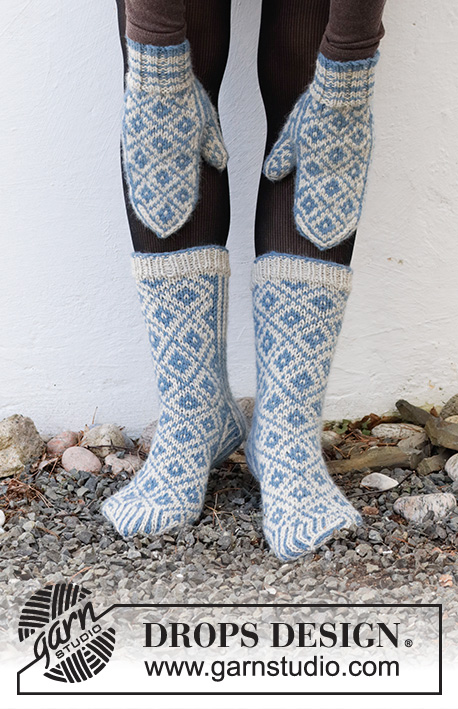 |
|||||||||||||||||||||
Rukavice palčáky a ponožky s norským vzorem pletené z příze DROPS Nepal. Velikost rukavic S/M – M/L. Velikost ponožek 35 – 43.
DROPS 214-54 |
||||||||||||||||||||||
|
------------------------------------------------------- VYSVĚTLIVKY: ------------------------------------------------------- VZOR: Rukavice: Viz schémata A.1 až A.4. Zvolte si schéma pro vaši velikost (platí pro A.1, A.2, A.x and A.y) Ponožky: Viz schémata A.5 a A.6. Celý vzor pleteme lícovým žerzejem, s výjimkou vzoru A.1, který je pletený pružným vzorem. TIP - PŘIDÁVÁNÍ/UJÍMÁNÍ: Abychom vypočítali, v jakých rozestupech máme přidávat/ujímat, vydělíme celkový počet ok na jehlici (tj. 36 ok) počtem ok, která potřebujeme přidat/ujmout (např. 4), takže 36 : 4 = 9. V tomto případě tedy 1x nahodíme za každým 9. okem. V následující kruhové řadě pleteme nahození za zadní nit, aby se v pletenině netvořily dírky. Pokud ujímáme, pak spleteme hladce dohromady každé 8. a 9. oko. TVAROVÁNÍ PATY: 1. ŘADA (= lícová): pleteme vzor A.6 až po posledních 4-5-5 ok, následující oko sejmeme hladce, 1 oko upleteme hladce a sejmuté přes ně přetáhneme, práci otočíme. 2. ŘADA (= rubová): pleteme vzor A.6 až po posledních 4-5-5 ok, následující oko sejmeme obrace, 1 oko upleteme obrace a sejmuté přes ně přetáhneme, práci otočíme. 3. ŘADA (= lícová): pleteme vzor A.6 až po poslední 3-4-4 oka, následující oko sejmeme hladce, 1 oko upleteme hladce a sejmuté přes ně přetáhneme, práci otočíme. 4. ŘADA (= rubová): pleteme vzor A.6 až po poslední 3-4-4 oka, následující oko sejmeme obrace, 1 oko upleteme obrace a sejmuté přes ně přetáhneme, práci otočíme. Tímto způsobem pokračujeme v ujímání (vždy o 1 oko snížíme počet ok zbylých v řadě) dokud nám na jehlicích nezůstane 9-9-11 ok. TIP - UJÍMÁNÍ (ponožky): Začínáme 2 oka před značkou: 2 oka spleteme hladce jinou barvou, než má označené oko, označené oko pak upleteme jako dříve, následující 2 oka spleteme hladce za zadní nit jinou barvou, než má označené oko. Stejně postupujeme i u druhé značky (= v kruhové řadě ujmeme 4 oka). ------------------------------------------------------- POPIS PRÁCE: ------------------------------------------------------- RUKAVICE - JAK BUDEME POSTUPOVAT: Pleteme v kruhových řadách na ponožkových jehlicích, zdola nahoru (tj. od lemu ke špičce), ve vyznačeném místě přidáme oka pro palec – tato oka pak odložíme na pomocnou jehlici a dopleteme tělo rukavice. Palec upleteme nakonec. PRAVÁ RUKAVICE: Na ponožkové jehlice č.3,5 nahodíme světle modrou přízí 36-40 ok a pleteme v kruhových řadách pružným vzorem 2/2, tj. střídáme 2 oka hladce, 2 obrace, barvy příze střídáme v pruzích dle schématu A.1. Po dokončení celé sekvence vzoru A.1 upleteme 1 kruhovou řadu hladce stříbrošedou přízí a SOUČASNĚ přidáme rovnoměrně 4-4 oka – viz TIP -PŘIDÁVÁNÍ/UJÍMÁNÍ = 40-44 ok. Pleteninu převedeme na ponožkové jehlice č.4 a rukavici dokončíme lícovým žerzejem. Pleteme vzor podle schématu A.2. SOUČASNĚ v 1. kruhové řadě pleteme nad 3 černými čtverečky ve vzoru A.2 vzor A.3. Pro vytvoření klínku pro palec přidáváme podle schématu A.3. Po dokončení celé sekvence vzoru A.3 (na výšku) máme ve vzoru A.3 přidaných 8 ok, takže celkem máme nyní 11 ok v klínku pro palec. V následující kruhové řadě odložíme těchto 11 ok na pomocnou jehlici a za nimi nahodíme 3 oka nová (oka nahodíme barvou dle schématu) = 40-44 ok. Pokračujeme vzorem A.2 nad všemi oky. Po dokončení celé sekvence vzoru A.2 zbývá na jehlicích 8 ok. Přízi odstřihneme, protáhneme zbylými oky, stáhneme a zapošijeme. PALEC: Odložených 11 ok palce vrátíme zpět na ponožkové jehlice č.4 a upleteme nad nimi prvních 11 ok první řady vzoru A.4 (= přední strana palce) - navíc k nim nabereme z okraje otvoru pro palec ještě 9 ok (tj. 2 oka na každé straně a 5 ok ze 3 nahozených ok); nad těmito 9 oky upleteme posledních 9 ok první řady vzoru A.4 (= zadní strana palce) = 20 ok. Pokračujeme v kruhových řadách vzorem A.4. Po dokončení celé sekvence vzoru A.4 zbývají v kruhové řadě 4 oka. Přízi odstřihneme, protáhneme zbylými oky, stáhneme a zapošijeme. LEVÁ RUKAVICE: Levou rukavici pleteme stejně jako pravou, jen zrcadlově převrácenou, tj. palec leží na opačné straně – viz schéma A.x, které zobrazuje umístění klínku ve vzoru. Po dokončení celé sekvence vzoru A.x (na výšku) pleteme až do ukončení práce vzor A.y. Palec pak pleteme stejným způsobem, jako u pravé rukavice. ------------------------------------------------------- PONOŽKY – JAK BUDEME POSTUPOVAT: Pleteme v kruhových řadách na ponožkových jehlicích, shora dolů. PONOŽKA: Na ponožkové jehlice č.3,5 nahodíme světle modrou přízí 50-52-54 ok. Přízi změníme na stříbrošedou a pleteme v kruhových řadách pružným vzorem 1/1, tj. střídáme 1 oko hladce, 1 obrace, do výše 3 cm. Pak upleteme 1 kruhovou řadu hladce stříbrošedou přízí a SOUČASNĚ ujmeme rovnoměrně 4 oka (platí pro všechny velikosti) – viz TIP – PŘIDÁVÁNÍ/UJÍMÁNÍ = 46-48-50 ok. Pleteninu převedeme na ponožkové jehlice č.4 a následující kruhovou řadu pleteme takto: prvních 30 ok pleteme vzorem A.5 (= 3 sekvence po 10 okách), pak 1. oko vzoru A.5 (aby byl vzor symetrický; těchto 31 ok tvoří přední stranu ponožky), 14-16-18 ok vzorem A.6 a nakonec 1. oko vzoru A.6 (aby byl vzor symetrický; těchto 15-17-19 ok tvoří zadní stranu ponožky). V tomto rozvržení pokračujeme. Po dokončení 3 celých sekvencí vzoru A.5 a A.6 (na výšku; platí pro všechny velikosti) odložíme 31 ok přední strany na pomocnou jehlici (tj. oka vzoru A.5; = nárt) = na jehlicích zbývá 15-17-19 ok paty. Nad oky paty upleteme v řadách 5-5,5-6 cm výšky vzorem A.6. Doprostřed poslední řady vložíme značku – později od ní budeme měřit délku chodidla. Teď TVARUJEME PATU – viz výše. Po vytvarování paty pleteme následující kruhovou řadu takto: 9-9-11 ok paty pleteme dál vzorem A.6, podél strany paty nabereme 8-10-12 ok (barvami dle vzoru A.6), odložených 31 ok nártu z pomocné jehlice upleteme vzorem A.5 a nabereme 8-10-12 ok podél druhé strany paty (barvami dle vzoru A.6) = na jehlicích máme 56-60-66 ok. 31 ok nártu pleteme dál vzorem A.5, ostatní oka vzorem A.6. SOUČASNĚ v 1. kruhové řadě začneme ujímat na každé straně 31 ok nártu – ujímáme vedle krajních ok vzoru A.6, takto: první oko vzoru A.6 upleteme jako dříve (toto oko není součástí ujímání, ale pleteme je stále světle modrou přízí), 2 oka spleteme světle šedou přízí hladce za zadní nit, pak pleteme vzor A.6 až po poslední 3 oka před vzorem A.5, 2 oka spleteme hladce světle šedou přízí a upleteme poslední oko vzoru A.6 jako dříve (toto oko není součástí ujímání, ale pleteme je stále světle modrou přízí). Takto ujímáme v každé 2. kruhové řadě, celkem 4-6-6x = 48-48-54 ok. Dál pleteme vzory A.5 a A.6, až do výše 18-20-22 cm od značky na patě (= do výsledných rozměrů zbývá doplést asi 4-4-5 cm výšky – ponožku teď můžete vyzkoušet a míry upravit, ale dbejte na to, abyste končili po dopletení poloviny nebo celé sekvence vzoru A.5 (na výšku)). Pokračujeme vzorem A.6 nad všemi oky, vzor přizpůsobíme tak, aby navazoval na vzor na chodidle. SOUČASNĚ si ve 2. kruhové řadě označíme boky ponožky – mezi značkami leží 23-23-27 ok nártu a 23-23-25 ok chodidla. Pleteme v kruhových řadách lícovým žerzejem a SOUČASNĚ tvarujeme špičku - ujímáme na obou stranách každého označeného oka – viz TIP - UJÍMÁNÍ = ujmeme 4 oka. Takto ujímáme v každé kruhové řadě, celkem 9-9-10x = 12-12-14 ok. V následující kruhové řadě spleteme každá 2 oka hladce = 6-6-7 ok. Přízi odstřihneme, protáhneme zbylými oky, stáhneme a zapošijeme. Ponožka měří asi 22-24-27 cm (od značky na patě, měřeno na chodidle). Stejným způsobem upleteme i druhou ponožku. |
||||||||||||||||||||||
Vysvětlivky ke schématu |
||||||||||||||||||||||
|
||||||||||||||||||||||
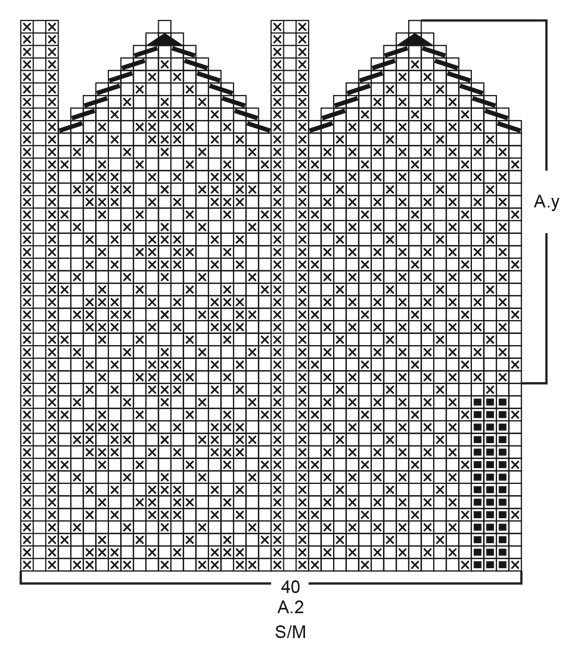
|
||||||||||||||||||||||
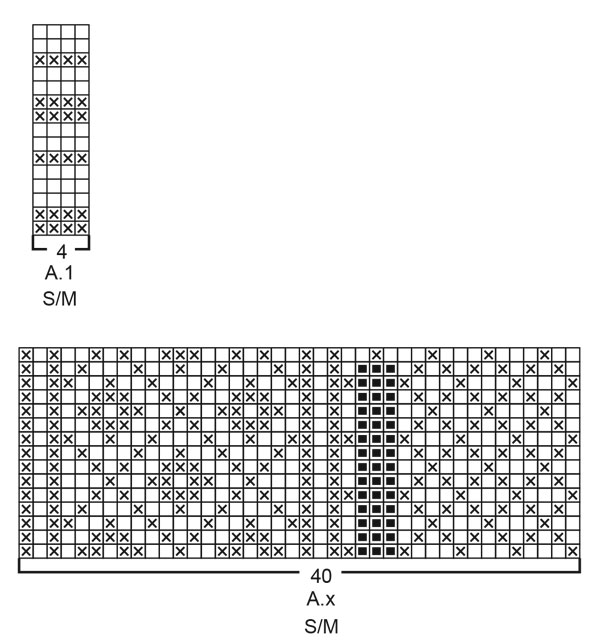
|
||||||||||||||||||||||
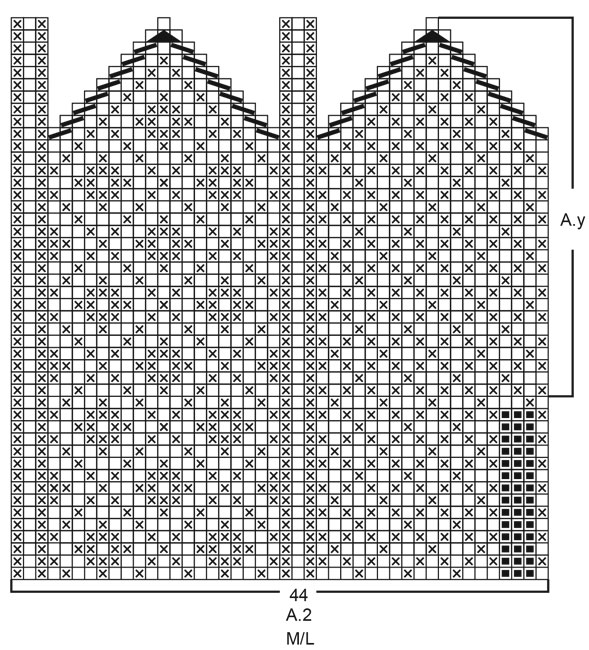
|
||||||||||||||||||||||
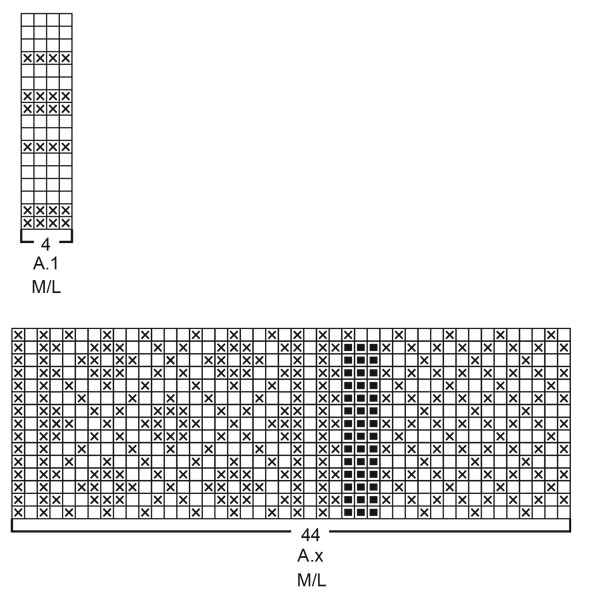
|
||||||||||||||||||||||
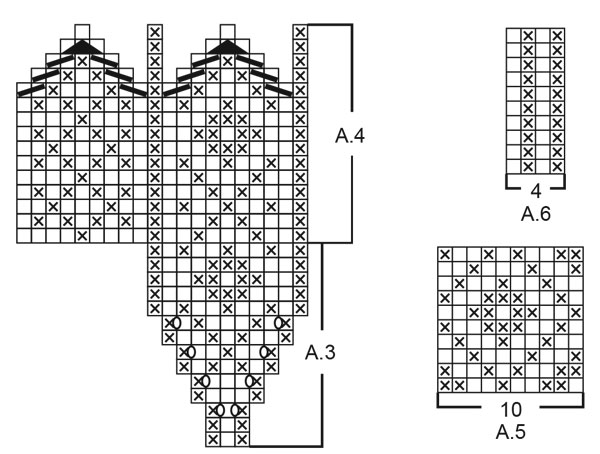
|
||||||||||||||||||||||
Dokončili jste tento model?Pak označte své fotky tagem #dropspattern #fjordmosaicsetsocks nebo je pošlete do galerie #dropsfan. Potřebujete s tímto návodem poradit?Otevřete-li si návod na stránce garnstudio.com, najdete tam 27 výukových video-ukázek, Komentáře/Dotazy a další užitečné informace. © 1982-2025 DROPS Design A/S. Vyhrazujeme si veškerá práva. Tento dokument, včetně všech jeho dílčích částí, podléhá autorským právům. Podrobnější komentář k možnostem užití našich návodů najdete dole pod každým návodem na našich stránkách. |
||||||||||||||||||||||







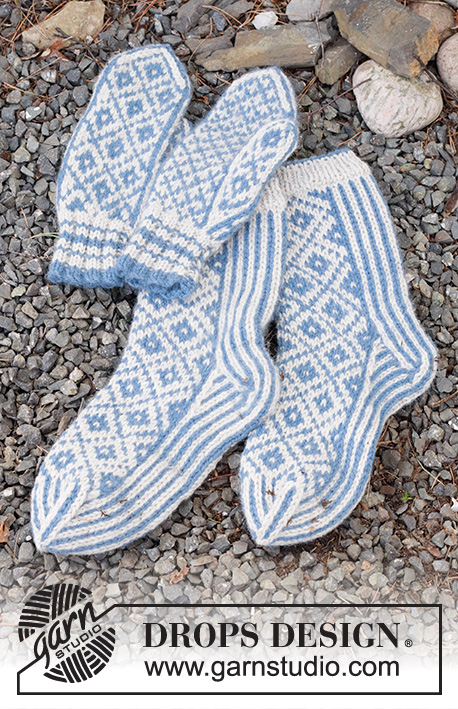

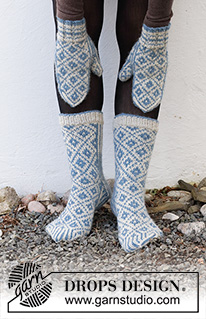
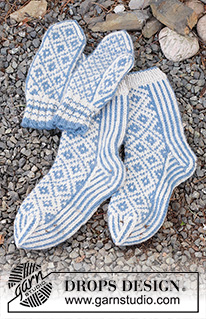























































Přidejte komentář k návodu DROPS 214-54
Rádi bychom věděli, co si o tomto modelu myslíte!
Pokud se chcete na něco zeptat, dbejte prosím na to, abyste ve formuláři níže vybrali správnou kategorii - díky tomu se dříve dozvíte, co potřebujete vědět. Povinná pole jsou označena *.